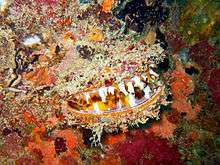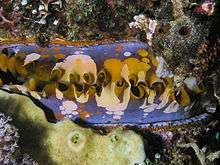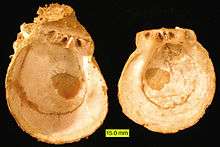Spondylus gaederopus
| Spondylus gaederopus Temporal range: Mesozoic–Present | |
|---|---|
 | |
| A shell of Spondylus regius | |
| Scientific classification | |
| Kingdom: | Animalia |
| Phylum: | Mollusca |
| Class: | Bivalvia |
| Order: | Pectinoida |
| Suborder: | Pectinina |
| Superfamily: | Pectinoidea |
| Family: | Spondylidae Gray, 1826 |
| Genus: | Spondylus Linnaeus, 1758 |
| Species | |
|
See text | |
Spondylus is a genus of bivalve molluscs, the only genus in the family Spondylidae. As well as being the systematic or scientific name, Spondylus is also the most often used common name for these animals, though they are also known as thorny oysters, spiny oysters, and as spondylids. The meat of these bivalves is edible.
The many species of Spondylus vary considerably in appearance and range. They are grouped in the same superfamily as the scallops. They are not closely related to true oysters (family Ostreidae), however they do cement themselves to rocks, rather than attach themselves by a byssus. Their key characteristic is the two parts of their shells are hinged together with a ball-and-socket type of hinge, rather than a toothed hinge as is more common in other bivalves. They also still retain vestigial anterior and posterior auricles ("ears", triangular shell flaps) along the hinge line.
Liks scallops, Spondylus spp. have multiple eyes around the edges of their shells, and have relatively well-developed nervous systems. Their nervous ganglia are concentrated in the visceral region, with recognisable optic lobes connected to the eyes.
Spondylus shells are much sought after by collectors, and a lively commercial market exists in them.
History
The genus Spondylus originated in the Mesozoic era and can be found in fossil forms in Cretaceous rocks in the Fort Worth Formation of Texas and in the Trent River Formation of Vancouver, as well as other parts of North America.[1][2]
Archaeological evidence shows people in Neolithic Europe were trading the shells of S. gaederopus to make bangles and other ornaments through much of the neolithic.[3] The main use period appears to have been from around 5350 BC to 4200BC.[3] The shells were harvested from the Aegean Sea, but were transported far into the centre of the continent. In the LBK and Lengyel cultures, Spondylus shells from the Aegean Sea were worked into bracelets and belt buckles. Over time styles changed with the middle neolithic favouring generally larger barrel-shaped beads and the late neolithic smaller flatter and disk shaped beads.[3] Significant finds of jewellery made from Spondylus shells were made at the Varna Necropolis. During the late Neolithic the use of Spondylus in grave goods appears to have been limited to woman and children.[3]
S. princeps is found off the coast of Ecuador, and has been important to Andean peoples since pre-Columbian times, serving as offerings to the Pachamama, as well as some kind of currency.[4] In fact, much like in Europe, the Spondylus shells also reached far and wide, as pre-Hispanic Ecuadorian peoples traded them with peoples as far north as present-day Mexico and as far south as the central Andes.[5] The Moche people of ancient Peru worshipped animals and the sea, and often depicted Spondylus shells in their art.[6]
Species



- S. americanus Hermann, 1781 — Atlantic thorny oyster
- S. anacanthus Mawe, 1823 — nude thorny oyster
- S. barbatus Reeve, 1856
- S. butleri Reeve, 1856
- S. calcifer Carpenter, 1857
- S. clarksoni Limpus, 1992
- S. crassisquama Lamarck, 1819 (S. princeps Broderip, 1833) — Pacific thorny oyster
- S. cruentus Lischke, 1868
- S. cumingii Sowerby, 1847
- S. dutempleanus Linnaeus, 1758
- S. echinatus Schreibers, 1793
- S. erectospinus Habe,1973
- S. erinaceus Reeve, 1856
- S. gaederopus Linnaeus, 1758 — European thorny oyster
- S. gilvus Reeve, 1856
- S. groschi Lamprell & Kilburn, 1995
- S. gussoni (O. G Costa, 1829)
- S. hawaiiensis Dall, Bartsch and Rehder, 1938
- S. hystrix Röding, 1798
- S. ictericus Reeve, 1856
- S. imbutus Reeve, 1856
- S. imperialis Chenu, 1843
- S. japonicus Kur — Japanese spiny oyster
- S. lamarcki Chenu, 1845
- S. layardi Reeve, 1856
- S. linguaefelis Sowerby, 1847
- S. longitudinalis Lamarck, 1819
- S. marisrubri Röding, 1798
- S. microlepos Lamarck, 1819
- S. multimuricatus Reeve, 1856
- S. multisetosus Reeve, 1856
- S. nicobaricus Schreibers, 1793
- S. occidens Sowerby, 1903
- S. plurispinosus Reeve, 1856
- S. powelli Smith, 1892
- S. pratii Parth, 1990
- S. regius Linnaeus, 1758 — regal thorny oyster
- S. sanguineus Dunker, 1852
- S. senegalensis Schreibers, 1793
- S. setiger Reeve, 1846
- S. sinensis Schreibers, 1793
- S. smythaea Lamprell, 1998
- S. somalicus M. Parth & R. Philippe, 1992
- S. squamosus Schreibers, 1793
- S. tenellus Reeve, 1856
- S. varius Sowerby,1829
- S. variegatus Schreibers, 1793
- S. versicolor Schreibers, 1793
- S. vexillum Reeve, 1856
- S. wrightianus Crosse, 1872 — Wright's thorny oyster
- S. zonalis Lamarck, 1819

References
- ↑ Finsley, Chalres. 1999. A Field Guide to the Fossils of Texas. Gulf Publishing. Lanham, Maryland. plate 55.
- ↑ Ludvigsen, Rolf & Beard, Graham. 1997. West Coast Fossils: A Guide to the Ancient Life of Vancouver Island. pg. 104
- 1 2 3 4 Gardelková-Vrtelová, Anna; Golej, Marián (2013). "The necklace from the Strážnice site in the Hodonín district (Czech Republic). A contribution on the subject of Spondylus jewellery in the Neolithic". Documenta Praehistorica. Znanstvena založba Filozofske fakultete Univerze v Ljubljani. 40: 265–277. doi:10.4312/dp.40.21. Retrieved 2 December 2015.

- ↑ Carter, Benjamin. "Spondylus in South American Prehistory" In Spondylus in Prehistory: New Data and Approaches. Ed. Fotis Ifantidis and Marianna Nikolaidou. BAR International Series 2216. Oxford: Archaeopress, 2011: 63-89.
- ↑ Shimada, Izumi. “Evolution of Andean Diversity: Regional Formations (500 B.C.E-C.E. 600). The Cambridge History of the Native People of the Americas. Vol. III, pt. 1. Ed. Frank Salomon & Stuart B. Schwartz. Cambridge: Cambridge University Press, 1999: 350-517, esp. "Mesoamerican-Northwest South American Connections", pp. 430-436.
- ↑ Berrin, Katherine & Larco Museum. The Spirit of Ancient Peru:Treasures from the Museo Arqueológico Rafael Larco Herrera. New York: Thames and Hudson, 1997.
External links
- Spondylus Session Abstracts on Spondylus research at the 13th Meeting of the European Association of Archaeologists at Zadar, Croatia, September 2007
- Information about Spondylus from the website of the Gladys Archerd Shell Collection at Washington State University Tri-Cities Natural History Museum
- Article on "notched" Spondylus Neolithic artifacts in Europe
Bibliography
- A full and constantly updated bibliography on Spondylus spp. in Aegean, Balkan, European and American contexts

